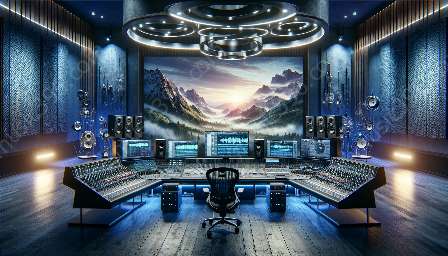Audio signal processing holds a vital role in our daily lives, from enhancing the sound quality of digital recordings to enabling voice recognition systems. As technology advances, machine learning has revolutionized the way we process and analyze audio signals, shaping the field of audio-visual signal processing. In this article, we delve into the intersection of machine learning and audio signal processing, exploring how this powerful combination impacts speech recognition, music processing, and sound analysis.
The Basics of Audio Signal Processing
Before delving into the role of machine learning in audio signal processing, it's essential to understand the fundamentals of this field. Audio signal processing involves the manipulation of sound waves, which are typically represented as digital signals. This encompasses a wide range of activities, including audio compression, equalization, noise reduction, and more.
One of the fundamental challenges in audio signal processing is the extraction of meaningful information from audio signals. For instance, in speech recognition systems, it is crucial to discern individual words from continuous speech and to identify different speakers accurately. Similarly, in music processing, tasks such as genre classification, instrument recognition, and melody extraction rely on efficient signal processing techniques.
The Intersection of Machine Learning and Audio Signal Processing
Machine learning has emerged as a powerful tool in audio signal processing, offering advanced techniques for extracting, analyzing, and understanding audio signals. By leveraging the vast amounts of audio data available, machine learning algorithms can learn patterns, extract features, and make predictions, greatly enhancing the capabilities of traditional signal processing methods.
One of the key advantages of machine learning in audio signal processing is its ability to adapt and learn from new data. Traditional signal processing techniques often rely on predefined rules and algorithms, which may not capture all the intricacies of complex audio signals. In contrast, machine learning models can automatically adapt to new patterns and variations, making them well-suited for real-world audio applications.
Impact on Sound Analysis
Machine learning techniques have significantly impacted the field of sound analysis, enabling the automatic identification and categorization of audio signals. This is particularly valuable in applications such as audio recognition, where machine learning models can be trained to recognize specific sounds, such as footsteps, car horns, or musical instruments, with high accuracy.
Moreover, machine learning algorithms can extract high-level features from audio signals, allowing for tasks such as sound event detection, environmental sound classification, and acoustic scene analysis. These capabilities have practical implications in areas like surveillance systems, environmental monitoring, and smart city technologies, where the automatic analysis of audio signals can provide valuable insights and enhance situational awareness.
Advancements in Speech Recognition
Speech recognition systems have greatly benefited from the integration of machine learning, enabling more accurate and robust speech-to-text conversion. Machine learning models, particularly deep learning architectures such as recurrent neural networks (RNNs) and convolutional neural networks (CNNs), have demonstrated remarkable performance in speech recognition tasks.
Through the training of large-scale speech datasets, machine learning algorithms can effectively learn the acoustic and linguistic patterns of different languages, dialects, and speaking styles. This has led to the development of voice-enabled virtual assistants, real-time transcription services, and voice biometrics systems, expanding the accessibility of speech recognition technology in diverse applications.
Enhancing Music Processing
Machine learning has also made significant strides in the field of music processing, enabling innovative approaches to tasks like music transcription, genre classification, recommendation systems, and automatic music composition. By analyzing audio features such as timbre, pitch, rhythm, and harmony, machine learning algorithms can extract meaningful representations of musical content, leading to improved music analysis and synthesis techniques.
For instance, music recommendation systems leverage machine learning to understand user preferences and tailor personalized music recommendations. This involves analyzing user listening habits, musical features of songs, and contextual information to deliver relevant and engaging music suggestions, enhancing the overall music listening experience for users.
Audio-Visual Signal Processing
Audio-visual signal processing extends the principles of audio signal processing to multimodal data, integrating audio and visual information for comprehensive signal analysis. The incorporation of machine learning techniques further enriches the capabilities of audio-visual signal processing, enabling complex tasks such as video captioning, audio-visual scene analysis, lip reading, and multimedia content understanding.
Machine learning has a profound impact on audio-visual signal processing by facilitating cross-modal analysis, where audio and visual features are jointly processed to reveal correlations and associations between different modalities. This paves the way for advanced multimedia applications, including human-computer interaction, content-based video retrieval, and gesture recognition systems that can understand and interpret both audio and visual cues.
Conclusion
Machine learning has become an indispensable component of modern audio signal processing, revolutionizing the way we analyze, process, and interpret audio signals. Its transformative impact extends beyond audio signal processing into the realm of audio-visual signal processing, where the integration of audio and visual information is enriched by advanced machine learning techniques. As technology continues to evolve, the fusion of machine learning and audio signal processing holds immense potential for creating innovative audio-visual experiences and enhancing the understanding of complex audio-visual content.


